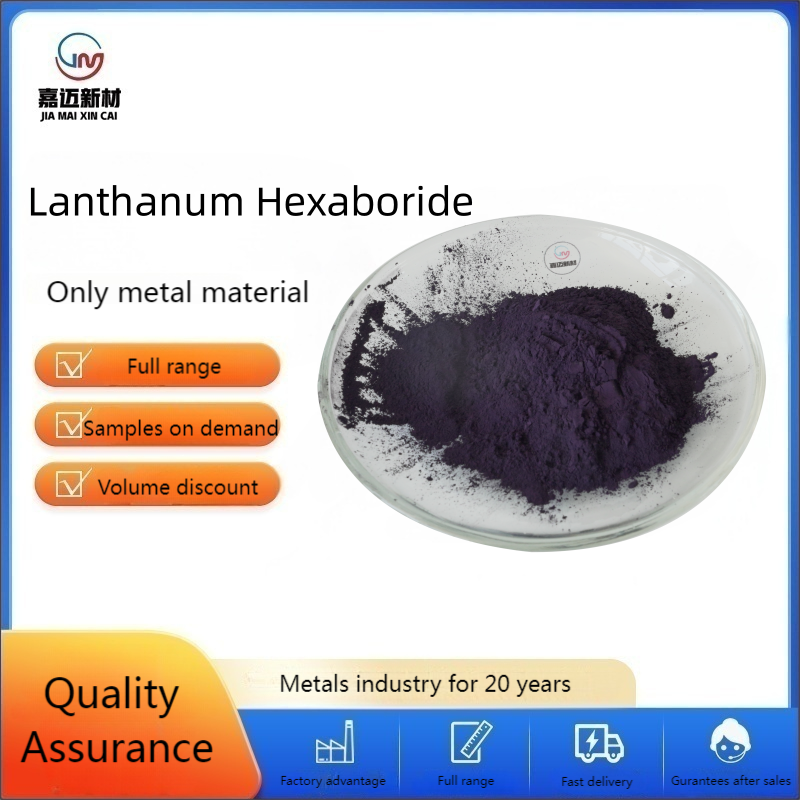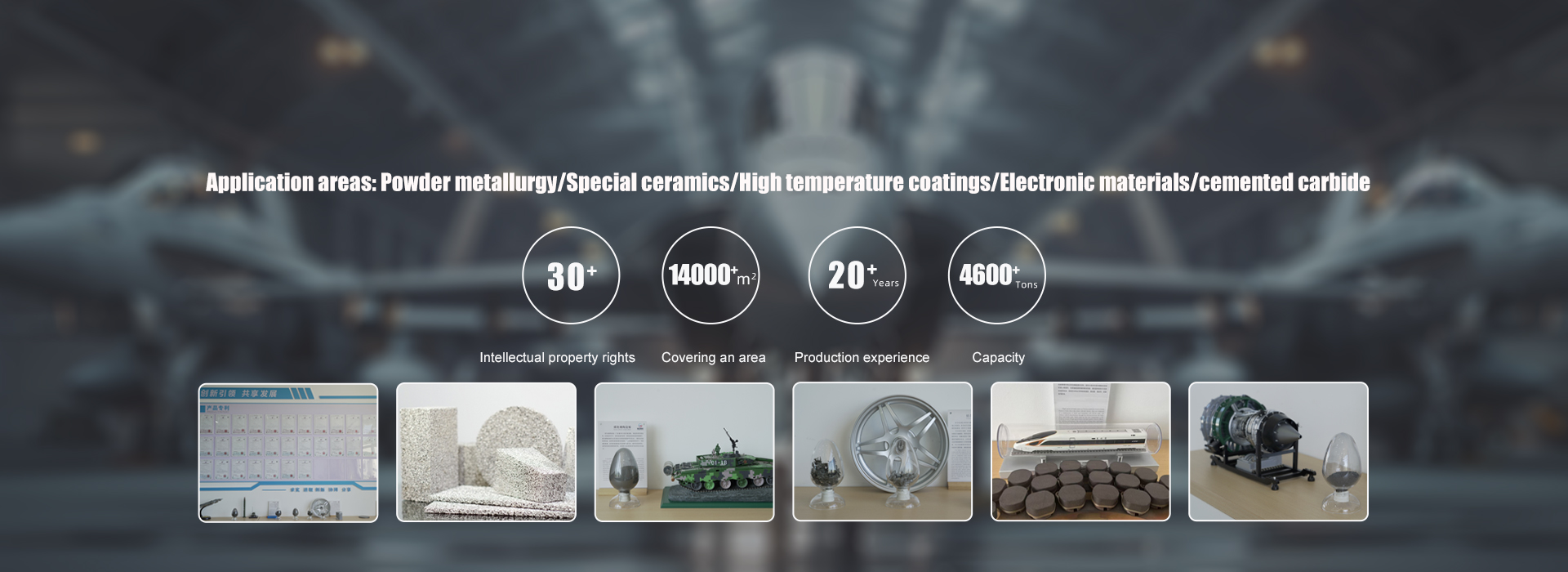
Rare earth borides refer to binary or multi-component compounds composed mainly of boron and rare earth elements with a relatively fixed stoichiometric relationship and stable structure. Currently, the research focus is on simple rare earth borides such as REB4, REB6, REB66, and (RE1x RE21 -x)B6 (where RE1 and RE2 represent two different rare earth elements), while there is less research on complex rare earth borides (or mixtures) such as LaB6-ZrB2 (Lax Ba1-x) B6 and (SmX Ba1-x) B6. Previously, the main research areas were the synthesis processes, methods, compositions, structures, properties, and physical and chemical properties of these substances. Now, the focus has shifted to improving the performance of LaB6 series products and their in-depth applications, the synthesis and application of new LaB6-containing composite materials, and the synthesis and application of rare earth boride nanomaterials. The research has gradually shifted from theoretical studies to application development.
Kremers G was the first to study the synthesis conditions of rare earth hexaborides in 1923. In 1929, Audrieax prepared rare earth hexaborides by molten salt electrolysis and explored the reaction mechanism of the process. In 1932, Allard G and Stackellberg M discovered that rare earth borides have a CsCl-type body-centered cubic crystal structure. In 1951, Lafferty J M found that lanthanum hexaboride has excellent electron emission properties, which aroused the interest of many scientists worldwide and initiated a research boom in rare earth borides. Since then, many researchers have proposed new synthesis methods and explored the physical and chemical properties and electronic structures of certain borides. For nearly a century, domestic and foreign scientists have never ceased their research on rare earth borides, including lanthanum hexaboride. Ukraine and Japan are the leading countries in this field, having started early and maintaining an international leading position. The first domestic institution to enter this field was the Baotou Research Institute of Rare Earths, which has successively prepared rare earth hexaboride powders, polycrystals, and single crystals.
1. Rare Earth Borides and Their Properties
1.1 Rare Earth Borides
At present, rare earth borides mainly consist of binary and ternary rare earth borides. Binary rare earth borides mainly include LaB6, CeB6, PrB6, NdB6, SmB6, EuB6, YB6, YB66, etc. in powder, polycrystalline and single crystal forms; ternary rare earth borides mainly include (La0.42Eu0.58)B6, (La0.44Sm0.56)B6. Other borides are still in the laboratory research stage. In addition, LaB6 - ZrB2, (LaxBa1-x)B6 and (SmxBa1-x)B6 are included in the series of composite compounds of rare earth borides with other elements (substances) doped.
1.2 Properties of Rare Earth Borides
Due to the special inner 4f orbitals of rare earth elements and the electron-deficient nature of boron, rare earth borides exhibit many excellent physical and chemical properties. Thermal properties: high melting point (LaB6 about 2715 ℃), low thermal expansion rate (thermal expansion coefficient is zero within a certain temperature range), and strong resistance to thermal radiation. Electrical properties: good electrical conductivity (LaB6 room temperature resistivity: 27μΩ·m), and constant resistivity. Electronic properties: low electron work function (LaB6 electron affinity: 2.66 eV, emission field: 29A/cm·K), the intermediate emission current of LaB6 cathode material can reach up to 100A/cm. Ion properties: good resistance to ion bombardment, capable of withstanding high electric fields (can operate normally under 100 MPa), and in vacuum or nitrogen atmosphere, pure (LaB6 close to 100%) single boron ions can be obtained using LaB6 cathode, forming a strong and stable ion beam. Radiation resistance: capable of absorbing neutrons and having strong radiation resistance. Chemical properties: stable chemical properties, not easily oxidized in air; does not react with acids except aqua regia, does not react with molten metals, and can be used as crucible materials. Mechanical properties: high hardness (LaB6 Vickers hardness 27.7 GPa).
1.3 Preparation Methods of Rare Earth Borides
1.3.1 Preparation Methods of Rare Earth Boride Powders and Polycrystals
The preparation methods of rare earth boride powders mainly include: element synthesis method, molten salt electrolysis method, magnesium reduction method, boron reduction method, boron carbide reduction method, microwave solid-state synthesis method, and zone melting method in suspension. Currently, the commonly used methods in production are the boron reduction method and the boron carbide reduction method. In industrial applications, LaB6 products, in addition to powders, also include columnar, tubular, rod-shaped, plate-shaped and needle-shaped polycrystalline products. The preparation of these products mainly uses hot pressing and cold pressing sintering methods.
1.3.2 Preparation Methods of Rare Earth Boride Single Crystals
The main methods for preparing rare earth boride single crystals include: flux growth method, molten salt electrolysis method, vapor deposition method, and zone melting method in suspension, etc. Although there are many methods, the most commonly used one is the induction heating zone melting method in suspension. With the induction heating zone melting device in suspension, large-sized single crystals of lanthanum hexaboride can be prepared. In the early 1980s, the double arc heating zone melting device in suspension was successfully developed, which can produce lanthanum hexaboride single crystal rods with a diameter of 7mm to 8mm. The equipment has a simple structure, is easy to operate, has high production efficiency, and excellent product quality. This device is currently used in industrial production.
2 Applications of Rare Earth Borides
The applications of rare earth borides are extremely wide-ranging, having been successfully utilized in over twenty military and high-tech fields such as radar, aerospace, electronics, instrumentation, medical equipment, household appliances, metallurgy, and environmental protection.
Military field: Lanthanum boride single crystals are the best choice for the cathodes of high-power electron tubes in radar.
Aerospace industry: They are used in plasma engines and thrusters. As a key material for many important components on meteorological satellites, high-temperature resistant nozzles made of lanthanum boride have extensive applications in aerospace.
Nuclear industry: Due to its strong radiation resistance, lanthanum boride can be used as radiation-resistant building bricks and various packaging materials in the nuclear industry.
Electronics industry: It is used in high-power electron tubes and magnetrons, electron and ion beams, and cathode materials for accelerators. Electron beams can be widely applied in integrated circuit processing, electronic engraving, particle accelerators, electron beam heating sources, and electron welding, among others.
High-tech instrumentation field: It is used in point light sources for electron microscopes and electron probe instruments, selective optical filters, and soft X-ray monochromators.
Household appliances: Lanthanum boride can produce high-density current and high brightness at medium and low temperatures, making it suitable for cathode materials in high-definition (plasma) ultra-thin television tubes, with great development potential.
Metallurgical industry: As an efficient additive, it has great application potential in special steels for weapons and military vehicles; it can also be made into containers for molten metals (such as crucibles).
Medical equipment field: It is used in plasma medical surgery instruments. Using this material as a cathode can generate argon plasma, which has cutting and coagulation effects on cell tissues and can be applied in throat, abdominal, and tumor and urological surgeries.
Environmental protection field: In environmental protection, electron beams are most suitable for treating flue gas and are recognized internationally as a new technology for flue gas treatment in the 21st century. There is no secondary pollution, and it is called the "ultimate process". Moreover, it can turn waste into treasure, and the generated ammonium sulfate and ammonium nitrate complex salts are excellent fertilizers.
Material processing equipment field: Electron welders made of lanthanum boride can meet the requirements of high-energy density welding processes and are widely used in aerospace, aviation, and weapons fields.
Biotechnology field: When lanthanum boride powder is coated on glass and irradiated with a special light source, it can increase crop yields. According to data provided by Ukrainian experts, it can increase yields by 15%.
Special glass field: Australian researchers Stefan Schelm and Geoff Smith B have developed a cheap plastic polymer containing lanthanum hexaboride grains. When pressed in the center of a glass sheet, it can resist "heat waves" with wavelengths shorter than red light. When observed at an angle, it emits a pale blue mist, while from other angles, it appears transparent and slightly green. This new type of glass allows light to enter but blocks most of the heat, keeping your office from feeling like a greenhouse in summer, even though the weight of the added grains only accounts for 0.02%, the infrared penetration rate drops to 5%.
3Research Status of Borides of Rare Earth Elements Abroad
From the discovery of the cathode emission characteristics of LaB6 by Lafferty in 1951 to the 1980s, rare earth borides were important materials in the defense and military fields. All countries kept them strictly confidential and imposed technological blockades. Apart from a few patents, no public reports were made. After being turned to civilian use in the 1980s, research on them became active and they have now become a research hotspot in the cross-disciplines of intermetallic compounds, inorganic non-metallic materials, ceramic materials, metallurgy, solid physics and chemistry.
The Institute of Materials Problems of the National Academy of Sciences of Ukraine, led by Y. B. Pader-no, has been engaged in in-depth research for over 20 years and is now capable of producing a series of products including boride powders, polycrystals and single crystals. In particular, they have successfully produced high-performance LaB6 single crystals using advanced techniques such as directional solidification and zone purification. They have also mastered related mechanical processing and welding techniques and developed tube, sheet and wire products. Their comprehensive research level is at the forefront of the world. This material has been widely used in both defense and civilian industries, such as high-power emission cathodes, accelerators, key components of electron and ion beams. They supply cathode materials for electron beam welding machines to the world-renowned Ukrainian Institute of Physics and Technology in large quantities. Their products are not only supplied to their own country and other countries in the Commonwealth of Independent States, but also exported to Japan, Germany, France, Bulgaria, Poland, the Czech Republic and other countries. All the large-sized LaB6 single crystals in the world are provided by Ukraine. They have provided Canada with a set of highly difficult tubular LaB6 single crystals for the manufacture of a special-purpose plasma beam.
To focus on the production of single crystals, the institute has transferred the production technology of powders to cooperative factories. Sometimes, they import high-purity powders from Germany to prepare high-quality single crystals. In addition, Ukraine is constantly expanding its research fields and has now involved dozens of new materials such as rare earth and transition (C, Si, Zr, Ti, Hf) element borides and composite compounds in powder synthesis, polycrystal preparation and single crystal growth technologies.
In recent years, Japan has made rapid progress in the application research of single crystals and has used them in various types of electron microscope cathodes. Toshiba Corporation and the National Institute of Materials Science in Japan have begun application research on cathode materials for the next generation of color TV picture tubes; LaB6 and SrB4 single crystals have been applied in high-definition color TVs. In terms of single crystal production, Japan has used the aluminum solvent method, arc heating zone melting method and the current radio frequency induction zone melting method. The first two methods produce small-sized single crystals with low quality qualification rates; the latter method produces larger-sized crystals, but the crystal quality has not yet reached the level of Ukraine.
The United States has also conducted research on LaB6 powders, polycrystals and compacted materials, and the powders have entered the commercial market. In terms of single crystal growth, filament-grown filamentous single crystals have begun to be used in microscope cathodes, but there are no reports on the growth of large-sized single crystals.
In addition, the production of LaB6 powder in Germany has been serialized. The United Kingdom, France, Switzerland and other countries have also successively conducted research on LaB6 materials in laboratory conditions.
It should be particularly pointed out that in recent years, the United States has conducted systematic research on the synthesis and application of rare earth boride nanomaterials and is in a leading position internationally. For instance, LaB6, CeB and GdB nanowires were prepared at 1150 ℃ by CVD method and their field emission properties were studied; LaB6 nanowires and nanotubes were synthesized at 1070 ℃ by self-catalytic reaction using La powder and BCl3; PrB6 nanowires were synthesized at 1050 ℃ by using Pr powder and BCl3; EuB6 nanowires and nanotubes were prepared at 950 ℃.
4. Research Status of Rare Earth Borides in China
Domestic institutions such as Baotou Research Institute of Rare Earths, Hunan Research Institute of Rare Earths, Institute of High Energy Physics of the Chinese Academy of Sciences, Institute of Chemistry of the Chinese Academy of Sciences, University of Electronic Science and Technology of China, Northwestern Polytechnical University, and Shandong University have successively conducted research on the preparation processes and application development of rare earth borides and their composite materials. In recent years, Beijing University of Technology has studied nanocrystalline bulk materials using spark plasma sintering technology, and Northeastern University has prepared lanthanum hexaboride powder using self-propagating high-temperature synthesis technology. The work of these institutions each has its own focus and characteristics.
Since the 1960s, the Baotou Research Institute of Rare Earths has been conducting research on the production processes of rare earth boride powders, cold-pressed blocks, hot-pressed blocks and shaped blocks. The products include binary rare earth borides such as LaB6, CeB6, PrB6, NdB6, SmB6, EuB6 and YB6; ternary rare earth borides (La0.42Eu0.58)B6 and (La0.44Sm0.56)B6; and composite compounds (LaxBa1-x)B6 and (SmxBa1-x)B6. In the early 1980s, the institute independently designed and manufactured a double-arc heating floating zone melting furnace for the production of rare earth boride single crystals, which was granted a national invention patent. The LaB6 single crystals produced by this furnace have reached international standards and have received high praise from users such as Beijing Normal University, Zhejiang University, the Institute of High Energy Physics of the Chinese Academy of Sciences, the Institute of Atomic Energy, and the University of Electronic Science and Technology of Chengdu. In 1983, the Ministry of Metallurgy's Military Industry Office organized an appraisal of this project and awarded it the third prize for scientific and technological progress of the Ministry of Metallurgy that year. The double-arc heating floating zone melting furnace for the preparation of rare earth boride single crystals won the fourth prize of the National Invention Award in 1990. The electronic probe standards made from rare earth boride single crystals have better stability and uniformity than the national standard (GB4930-85), and have been approved by the State Bureau of Technical Supervision as national electronic probe standards. This new type of probe standard is also a first.
The Hunan Institute of Rare Earths is also one of the earliest domestic institutions to study rare earth borides. It has successively prepared powders and polycrystals of rare earth borides such as LaB6, and still provides products to the outside world. The Institute of Chemistry of the Chinese Academy of Sciences began to develop LaB6 products in 1958 and achieved success, but the research was terminated after the Cultural Revolution. Chen Changming and Zhou Wancheng from Northwestern Polytechnical University conducted systematic research on composite rare earth borides such as the LaB6-ZrB2 series. There are no reports on simple rare earth borides. In 1997, Shandong University began to research LaB6 series materials and implemented a long-term, progressive research plan of "powder - polycrystal - single crystal - eutectic composite material". The basic research work is relatively systematic and solid. From the current reports, their powder and polycrystal products are good, but there are no reports on eutectic composite materials. In recent years, the School of Materials and Metallurgy of Northeastern University has successfully prepared LaB6 micro-powders using the self-propagating high-temperature synthesis method. Zhang Ning and others from Beijing University of Technology have successfully prepared high-quality, high-purity and large-sized LaB6 and CeB6 single crystals using the pure element synthesis method and systematically analyzed the influence of each parameter in the preparation process on crystal growth, determining the optimal process for crystal growth. The Institute of Chemistry of Jilin University has studied a new method for synthesizing boron-rich rare earth borides such as NdB6 under high-temperature and high-pressure extreme conditions using a 4.903MN ring belt two-sided press. Zhang Maofeng and others used BO as the boron source and synthesized rare earth boride nanocubes in a reaction vessel at 500°C and 5MPa; they used NaBH as the boron source and synthesized rare earth boride nanoparticles in a reaction vessel at 400°C and 10MPa. Su Yuchang and others from Central South University synthesized nano LaB6 by microwave solid-state reaction using La2O3 and KBH4 as raw materials and studied its microstructure and optical transmission properties. Huang Meisong and others from Hunan Institute of Rare Earth Metal Materials prepared LaB6 by boron carbide reduction method. They first purified the raw materials and then produced LaB6 powder with Fe content lower than 0.01% and C content lower than 0.02%. The yield of LaB6 in the entire process was 79.5%. Zhao Xiaohua from Shandong University studied the magnetron sputtering preparation process and growth mechanism of single-crystal silicon-based LaB6 thin films. The Institute of High Energy Physics of the Chinese Academy of Sciences, University of Electronic Science and Technology of China, Beijing Normal University, Zhejiang University and other domestic LaB6 production units have successively conducted tests and research on the physical and chemical properties, thermal properties and electronic properties of LaB6. Different types of polycrystalline LaB6 cathode materials (thin films, ring cathode lamps) have been developed for various applications.
5. Research Prospects of Rare Earth Borides
Rare earth borides and their extended materials (composite compounds) are high-tech products with wide application fields and strong potential for development. With the advancement of the commercialization process of rare earth functional materials, their application scope is gradually expanding, and the domestic and international market demand is also growing rapidly. These products have high added value. For instance, the single crystal with the greatest difficulty in production, the widest application, and the highest price, sells for up to 500 US dollars per gram in Japan. Currently, the world production of lanthanum hexaboride series products is less than 10 tons, while the demand is over 50 tons. The domestic annual demand is approximately 700 kilograms and is increasing at a rate of about 15% per year. Therefore, intensifying the research and development of rare earth borides is of significant theoretical and practical importance both technologically and commercially.
So far, scientific and technological personnel have conducted relatively thorough and clear research on the preparation process, structural characteristics, and physical and chemical properties of lanthanum hexaboride, a representative substance in the rare earth boride family. The research scope of application fields is gradually expanding. Compared with lanthanum hexaboride, the research on other binary and ternary borides is relatively less. Therefore, for simple rare earth borides, in addition to continuing to improve the research on lanthanum hexaboride for cathode emission materials, efforts should be concentrated on developing new application fields, modifying polycrystalline cathode materials, and preparing high-performance shaped polycrystals and large-sized single crystals. For composite rare earth borides, the application research as additives to improve the performance of composite materials in both defense and civilian fields is also one of the main contents of future research. For example, LaB6 - ZrB2, a high-temperature structural material that is being studied and is highly likely to be used in aircraft turbine blades; using LaB6 material to make the transparent cathode of transparent organic light-emitting diodes, which is more conducive to achieving full-color, high-resolution flat panel displays; dispersing LaB6 grains with plastic polymers and sandwiching them between glass to create a new type of heat-insulating glass that only allows light to enter while blocking most of the heat. Such applications have extremely high value and are highly concerned and interesting research fields for scientific and technological personnel. Once developed successfully, their economic and social benefits will be considerable. Similar application research will be the focus of future rare earth boride research.
6Suggestions for the Research on Rare Earth Borides in China
The research on rare earth borides in China started early but progressed slowly, with mediocre results. Over the years, there has been no comprehensive and systematic research. To change this situation and catch up with or surpass the world's advanced level, it is necessary to enhance the cooperation among the state, enterprises and technical personnel, and work together to solve problems.
From a macro perspective, the state should attach great importance to the research on rare earth borides in China, make full use of China's unique rare earth resources, increase investment, strengthen basic theoretical and practical application research, cultivate a group of researchers with strong capabilities in rare earth borides, form a team, and strive to reach or exceed the world level within 5 to 10 years. Enterprises should have a long-term strategic vision, cooperate with the state and researchers to build research and testing platforms, and quickly achieve the localization, serialization, scale-up and commercialization of boride application products in China.
From a micro perspective, researchers should, on the basis of learning and drawing on advanced foreign technologies, work diligently and establish basic research laboratories, engineering laboratories and industrialization bases to comprehensively and systematically study the synthesis methods, structures, and properties of various borides and composite compounds, master the characteristics of various materials, and in addition to tracking the latest world technologies, focus on developing application products with independent intellectual property rights.
In the future, China should focus on the following aspects for in-depth research and development of rare earth borides:
1. Develop the purification and deep processing technology of lanthanum hexaboride, further reduce production costs and improve product quality, such as using BC4 to produce high-purity LaB6 powder and single crystals; develop special-shaped products and large-sized single crystals.
2. Strengthen the research on binary and ternary rare earth borides containing light rare earths, study their synthesis processes, structural characteristics, physical and chemical properties, and optical, electrical, magnetic, thermal and mechanical properties, so as to further explore and expand new application fields.
3. Study the synthesis processes, structural characteristics, physical and chemical properties, and optical, electrical, magnetic, thermal and mechanical properties of rare earth boride composite compounds, and discover new functional materials.
4. Vigorously strengthen the research on application basics and product development, selectively and purposefully carry out breakthroughs, develop new materials and products for national defense and civilian use, and enable rare earth borides to truly enter the main battlefield of the national economy.
5. Research the nanofabrication technology, trace additive technology and application technology of rare earth borides.








